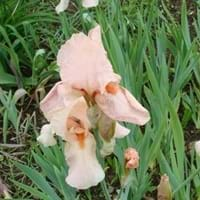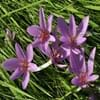Life Span
Perennial
Perennial
Type
Bulb or Corm or Tuber
Perennial
Origin
Hybrid origin
Hybrid origin
Types
boissieri , cupanii , hungaricum , kesselringii
Not Available
Number of Varieties
Not Available
Habitat
Temperate Regions
gardens, Hillside, Riverbanks, Warmer regions, Wet forest
USDA Hardiness Zone
Not Available
5-9
AHS Heat Zone
Not Available
9-1
Sunset Zone
21,22
1a, 1b, 2a, 2b, 3a, 3b, 4, 5, 6, 7, 8, 9, 10, 11, 12, 14, 15, 16, 17, 18, 19, 20, 21, 22, 23, 24
Habit
Clump-Forming
Clump-Forming
Flower Color
Purple, Violet
White, Yellow, Blue, Purple, Orange, Pink, Rose, Coral, Peach, Burgundy, Lavender, Plum, Orange Red, Dark Salmon, Bronze, Chocolate, Black
Flower Color Modifier
Bicolor
Bicolor
Fruit Color
Not Available
Not Available
Leaf Color in Spring
Green
Light Green, Blue Green
Leaf Color in Summer
Light Green
Light Green, Blue Green
Leaf Color in Fall
Several shades of Green
Light Green, Blue Green
Leaf Color in Winter
Light Green
Light Green
Leaf Shape
Long Linear
Long Linear
Plant Season
Spring, Fall
Spring
Sunlight
Full Sun, Partial Sun
Full Sun, Partial Sun
Growth Rate
Medium
Medium
Type of Soil
Loam
Clay, Loam, Sand
The pH of Soil
Acidic, Neutral
Acidic, Neutral, Alkaline
Soil Drainage
Well drained
Well drained
Bloom Time
Late Summer, Early Fall
Spring
Tolerances
Drought
Drought
Where to Plant?
Ground
Ground, Pot
How to Plant?
Divison, From bulbs, Seedlings
From Rhizomes, Stem Planting
Plant Maintenance
Medium
Medium
Watering Requirements
Keep ground moist
Does not require lot of watering, Keep ground moist, Water when soil is dry
In Summer
Lots of watering
Lots of watering
In Spring
Moderate
Moderate
In Winter
Average Water
Average Water
Soil pH
Acidic, Neutral
Acidic, Neutral, Alkaline
Soil Type
Loam
Clay, Loam, Sand
Soil Drainage Capacity
Well drained
Well drained
Sun Exposure
Full Sun, Partial Sun
Full Sun, Partial Sun
Pruning
no pruning required
Remove damaged leaves, Remove dead branches, Remove dead leaves
Fertilizers
All-Purpose Liquid Fertilizer
All-Purpose Liquid Fertilizer
Pests and Diseases
Dry root rot, Pest Free
Bacterial Diseases, Fungal Diseases, Viruses
Plant Tolerance
Drought
Drought
Flower Petal Number
Single
Single
Foliage Texture
Coarse
Medium
Foliage Sheen
Glossy
Matte
Attracts
Whiteflies
Bees, Butterflies
Allergy
Poisonous to grazing animals
Asthma
Aesthetic Uses
along a porch, deck or patio, Borders, Mixed Border, small hedge
Beautification, Showy Purposes
Beauty Benefits
No Beauty Benefits
Not Available
Environmental Uses
Air purification
Air purification
Medicinal Uses
anti rheumatic, cathartic
No Medicinal Use
Part of Plant Used
Root
Flowers, Leaves, Rhizomes, Root
Other Uses
Showy Purposes
Making Perfumes, Oil is used for aromatherapy, Used as a sedative, Used as essential oil
Used As Indoor Plant
No
No
Used As Outdoor Plant
Yes
Yes
Garden Design
Container, Cutflower, Foundation, Lawns and Turf, Mixed Border
Cutflower, Foundation, Mixed Border, Rock Garden, Wall
Botanical Name
COLCHICUM 'Lilac Wonder'
IRIS 'Beverly Sills'
Common Name
Hybrid Autumn Crocus, Hybrid Meadow Saffron
Iris-Tall Bearded
In Hindi
meadow saffron
Beverly Sills Iris Plant
In German
Herbstzeitlose
Beverly Sills Iris Pflanze
In French
Colchique d'automne
Beverly Sills Iris Plante
In Spanish
Estado de conservación
Planta Iris Sills Beverly
In Greek
meadow saffron
Μπέβερλι Σιλς Iris Φυτών
In Portuguese
Colchicum autumnale
Beverly Sills Iris planta
In Polish
Colchicum autumnale
Beverly Sills Iris Roślin
In Latin
autumnale
Beverly Sills Iris Planta
Phylum
Tracheophyta
Magnoliophyta
Class
Magnoliopsida
Liliopsida
Family
Liliaceae
Iridaceae
Clade
Angiosperms, Monocots
Not Available
Tribe
Not Available
Not Available
Subfamily
Not Available
Not Available
Number of Species
Not Available
Not Available
Season and Care of Meadow Saffron and Beverly Sills Iris
Season and care of Meadow Saffron and Beverly Sills Iris is important to know. While considering everything about Meadow Saffron and Beverly Sills Iris Care, growing season is an essential factor. Meadow Saffron season is Spring and Fall and Beverly Sills Iris season is Spring and Fall. The type of soil for Meadow Saffron is Loam and for Beverly Sills Iris is Clay, Loam, Sand while the PH of soil for Meadow Saffron is Acidic, Neutral and for Beverly Sills Iris is Acidic, Neutral, Alkaline.
Meadow Saffron and Beverly Sills Iris Physical Information
Meadow Saffron and Beverly Sills Iris physical information is very important for comparison. Meadow Saffron height is 12.70 cm and width 20.30 cm whereas Beverly Sills Iris height is 50.80 cm and width 50.80 cm. The color specification of Meadow Saffron and Beverly Sills Iris are as follows:
Meadow Saffron flower color: Purple and Violet
Meadow Saffron leaf color: Green
Beverly Sills Iris flower color: White, Yellow, Blue, Purple, Orange, Pink, Rose, Coral, Peach, Burgundy, Lavender, Plum, Orange Red, Dark Salmon, Bronze, Chocolate and Black
- Beverly Sills Iris leaf color: Light Green and Blue Green
Care of Meadow Saffron and Beverly Sills Iris
Care of Meadow Saffron and Beverly Sills Iris include pruning, fertilizers, watering etc. Meadow Saffron pruning is done no pruning required and Beverly Sills Iris pruning is done Remove damaged leaves, Remove dead branches and Remove dead leaves. In summer Meadow Saffron needs Lots of watering and in winter, it needs Average Water. Whereas, in summer Beverly Sills Iris needs Lots of watering and in winter, it needs Average Water.





